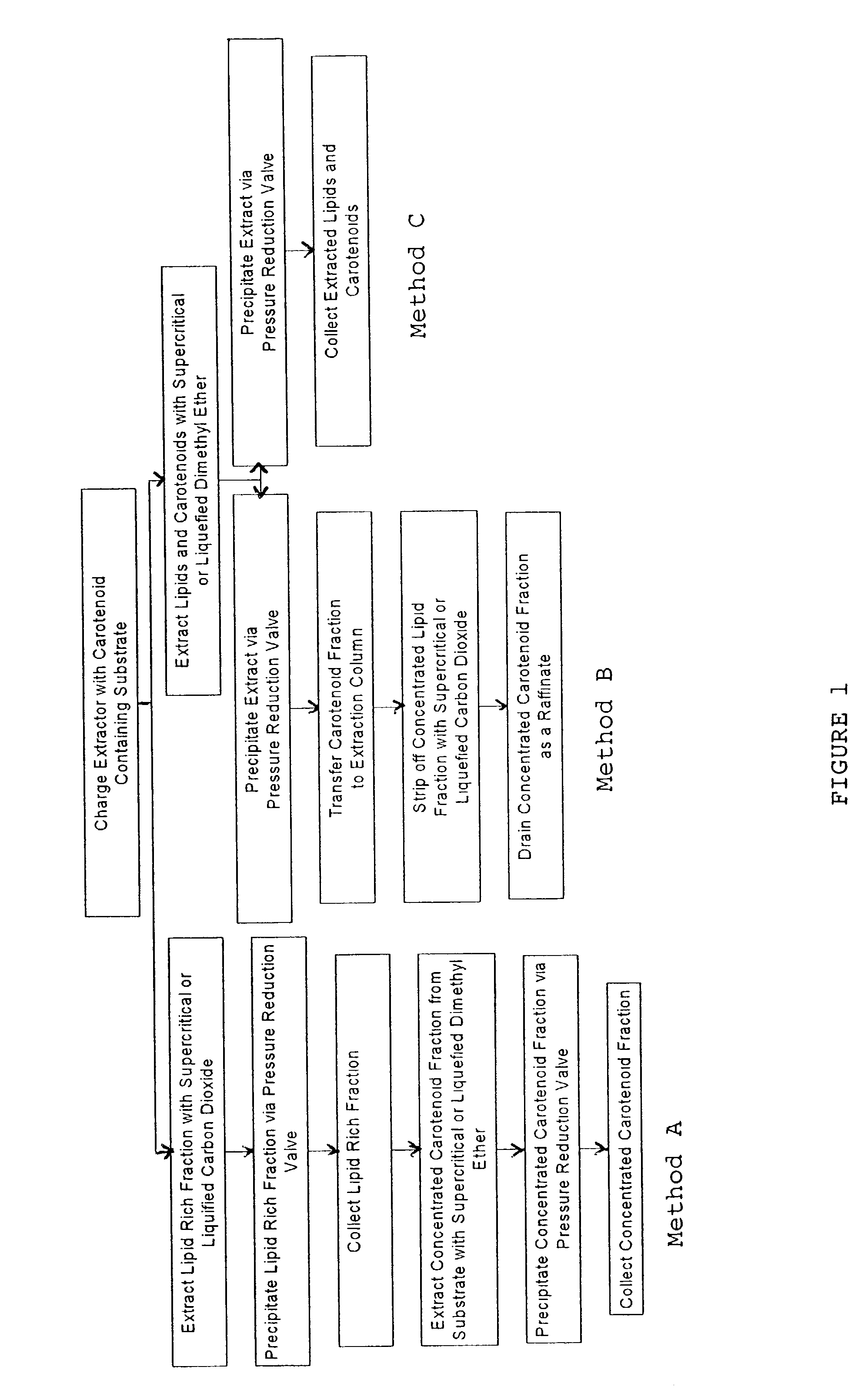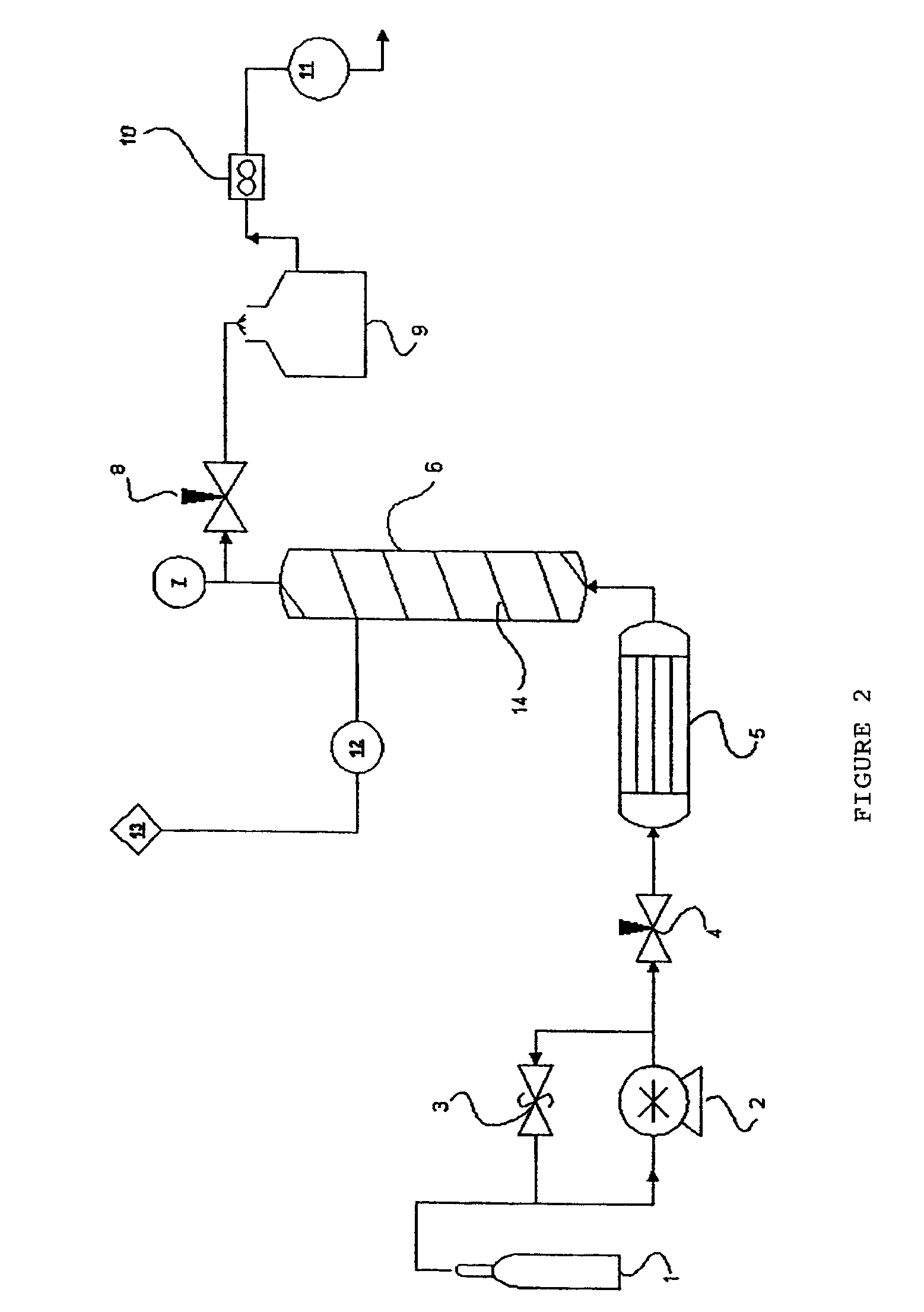Method for extraction and concentration of carotenoids using supercritical fluids
a technology of supercritical fluids and carotenoids, applied in the direction of prosthesis, bulk chemical production, separation processes, etc., can solve the problems of degrading the sensitive extract, ethanol can harm the sensitive extract, and both solvents are losing favor in the nutraceutical industry
- Summary
- Abstract
- Description
- Claims
- Application Information
AI Technical Summary
Benefits of technology
Problems solved by technology
Method used
Image
Examples
example 1
[0030]Following the procedure described above, 31.0 grams of Haematococcus pluvialis algae was charged to the extraction vessel and dimethyl ether was used as the extracting solvent. Dimethyl ether was used in its liquefied state at 1500 psi and 45° C. A quantity of 900 grams of dimethyl ether was passed through the extraction vessel, and 8.9 grams of extract was collected. The spent biomass was then recovered from the vessel and the extract and the biomass were analyzed for astaxanthin content. Table 1 shows the analytical results.
[0031]
TABLE 1ANALYTICAL RESULTS FOR EXAMPLE 1Concentration ofSampleWeight (grams)Astaxanthin (% w / w)Charge of algae31.01.6Extract8.95.5Residue21.70.08
[0032]Substantially, all of the astaxanthin from the charge of algae was recovered in the extract; the yield was 98%.
example 2
[0033]A quantity (46.1 grams) of Haematococcus pluvialis was charged to the extraction vessel. A two step procedure was employed in order to concentrate the recovered astaxanthin to a greater degree. In the first step, supercritical carbon dioxide at 60° C. and 2800 psi was used, and a total of 1200 grams of gas was passed through the extraction vessel. A total of 8.1 grams was extracted in this first fraction. The experimental system was then degassed to atmospheric pressure. A total of 500 g of liquified dimethyl ether at 40° C. and 1500 psi was then passed through the extraction chamber and 5.1 grams of viscous liquid was extracted. Thus, a total of 13.2 grams of extract was collected in the two fractions. A yield of 31.6 grams of biomass was recovered as residue from the extraction chamber. The weights and astaxanthin concentration are summarized in Table 2.
[0034]
TABLE 2ANALYTICAL RESULTS FOR EXAMPLE 2Concentration ofSampleWeight (grams)Astaxanthin (% w / w)Charge of algae46.11.6C...
example 3
[0036]A third example demonstrates an alternative two step process. In the first step, the astaxanthin and associated lipid in the algae substrate was extracted with dimethyl ether following the procedure of Example 1. Then, in a counter current column, a second step involving stripping off the lipid portion of the resulting extract with sub or supercritical carbon dioxide was carried out. For this example, 56.3 grams of Haematococcus pluvialis algae was loaded to the extraction vessel and 900 grams of dimethyl ether at 1500 psi and 45° C. was passed through the bed of algae. A total of 15.8 grams of extract was obtained. This extract was then charged to another extraction vessel to simulate a countercurrent column and supercritical carbon dioxide was passed through the new charge (of 15.8 g) at 2800 psi and 40° C. In this step 9.7 grams of a low viscosity, oily material was extracted with supercritical CO2, and a quantity of 6.0 grams of remaining material was drained from the extr...
PUM
| Property | Measurement | Unit |
|---|---|---|
| temperature | aaaaa | aaaaa |
| pressure | aaaaa | aaaaa |
| pressure | aaaaa | aaaaa |
Abstract
Description
Claims
Application Information
 Login to View More
Login to View More - R&D
- Intellectual Property
- Life Sciences
- Materials
- Tech Scout
- Unparalleled Data Quality
- Higher Quality Content
- 60% Fewer Hallucinations
Browse by: Latest US Patents, China's latest patents, Technical Efficacy Thesaurus, Application Domain, Technology Topic, Popular Technical Reports.
© 2025 PatSnap. All rights reserved.Legal|Privacy policy|Modern Slavery Act Transparency Statement|Sitemap|About US| Contact US: help@patsnap.com


